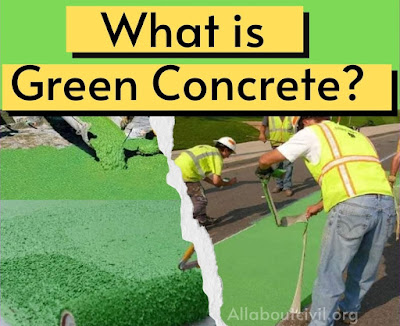Green Concrete -It is a form of concrete which is eco-friendly to the environment that uses less the energy in its production and produces less carbon dioxide when compared to the normal concrete.
The motto of Green Concrete is taken to mean, It should be environment-friendly concrete.
As we know cement is the main ingredient in concrete, the manufacturing process of cement leads to the carbon emission because the ingredients of cement are heated to about 800-10000 C. In order to curb the co2 emission, Green Concrete came into existence.
DID YOU KNOW?
For every 1 kg of cement produced approximately 0.9kg of carbon dioxide is released to the atmosphere. In year 2020 4.1 Billion metric ton cement produced worldwide.
HOW GREEN CONCRETE IS MADE
Green concrete may be made by adding waste materials as a partial or complete replacement for cement or coarse or fine aggregate. Whereas the process making remains same as Conventional concrete.
GREEN CONCRETE MATERIALS
Locally available
Construction materials, components, and systems found locally or regionally, saving energy and resources in transportation to the project site.
Salvaged, re-furnished, or re-manufactured
Includes saving material from disposal and renovating, repairing, restoring, or generally improving the appearance, performance, quality, functionality, or value of a product.
Reusable or recyclable
Select materials that can be easily dismantled and reused or recycled at the end of their useful life.
- Recycled Demolition Waste Aggregate
- Recycled Concrete Aggregate
- Blast furnace slag
- Manufactured Sand
- Glass Aggregate
- Fly ash
IMPROVED PROPERTIES
1- Mix can result in a reduced paste volume within the concrete structure resulting in a higher level of protection against concrete deterioration.
2- Higher strength per kilogram of cement
3- Increased durability and lower permeability
4- More aggregates typically mean higher Modulus of elasticity.
ADVANTAGES OF GREEN CONCRETE
1- Eco-friendly concrete, Helps in reducing carbon dioxide emission.
2- Optimized mix designs mean easier handling, better consistency and easier finishing
3- Reduction in shrinkage and creep
4- Green Concrete uses local and recycled materials in concrete.
5- The heat of hydration of green concrete is significantly lower than traditional concrete
6-low cost as compared to the Conventional concrete.
7-It is thermal and acid resistance.
DISADVANTAGES OF GREEN CONCRETE
1-Water absorption is high as compared to Conventional concrete
2-Lifespan of the Green concrete buildings or structures is less as compared to the structure constructed with conventional concrete.
3-Tension strength is less as compared to the conventional concrete.
4-Less Flexural Strength
APPLICATIONS OF GREEN CONCRETE
1-Road Construction
2-Building construction
3-Bridges
4-Dams
5-Retaining Walls, Columns etc..
Also Read : Different Types of Footings Used in Construction

